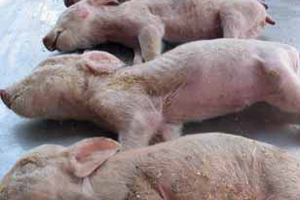Porcine Epidemic Diarrhoea growing stronger in Asia

Porcine Epidemic Diarrhoea (PED) virus has been around in Europe for some time and can be considered reasonably controlled. In Asia, on the other hand, the disease continues to cause heavy problems, partly due to co-infection. Where has the disease hit particularly and what can be done about it?
Coronaviruses can be divided into three serologically distinct subgroups. Alphacoronavirus and Betacoronavirus have been isolated from mammals and Gammacoronavirus from birds.
They infect many animals including humans, in species-specific manner. It has been reported that coronaviruses mainly infect respiratory and gastrointestinal tracts causing acute and chronic respiratory and enteric disorders in respective species. Together with Transmissible Gastro-enteritis virus (TGEV), Canine Corona-virus, Feline Infectious Peritonitis virus (FIPV), Porcine Epidemic Diarrhoea virus (PEDV) belongs to the subgroup of Alphacoronavirus. It is an economically very detrimental pathogen and is currently one of the hottest topics in pig industry, especially in the Asian swine market. PEDV results in approximately 50% mortality among suckling piglets. In addition, it reduces the weight of finishing pigs.
Pathology
PEDV has been known as the major cause of seasonal (winter period) acute diarrhoea in piglets. The pathology of a PEDV infection is mainly characterised by acute watery diarrhoea and dehydration in suckling piglets. It attacks the gastrointestinal tract and causes the destruction of villous enterocytes and villous atrophy within the jejunum and ileum, resulting in induced watery diarrhoea. Incubation period is very short and clinical signs start at 15-24 hours after infection and last usually two to three days. Transmission is very fast and once clinical signs are detected, most of the piglets in either house or whole farms are infected within two to three days.
The PED virus is pathologically similar to another swine coronavirus, Transmissible Gastroenteritis virus (TGEV), making it difficult to differentiate the two based on clinical symptoms alone. Although PED infection is enteric disease clinically and pathologically similar to transmissible gastroenteritis virus infection, two viruses are not serologically related to each other.
Description
Porcine Epidemic Diarrhoea was first described in 1971 in the United Kingdom and later in the decade in both the UK and Belgium. The virus has since been reported in other European countries. There, PEDV led to heavy losses to the swine industry as exemplified in the Belgian outbreak, where swine of all ages suffered from diarrhoea with 50% reported mortality in one-week old piglets.
In Europe, PED was mainly prevalent throughout the 1980s and 1990s (see Figure 1). The economic impact of the disease was not extremely significant, mainly due to a tight biosecurity. Only Italy reported a recent PEDV outbreak, from May 2005 until June 2006. A demand for vaccines, however, never arose in Europe.
In Asia, however, the situation developed differently. The disease was reported as from 1993 – first in Japan. After that, the disease was reported in several countries in the Asian territories, like China and Korea, see Figure 1. Outbreaks were observed throughout the year but most outbreaks have been reported during the cold winter season. With vaccination efforts and high biosecurity programmes, both South Korea and Japan managed to diminish the outbreaks. The financial impact therefore in these countries is very limited.
Where biosecurity situations are relatively bad, however, transmission and co-infection lead to high mortality rates. The situation in some other Asian countries therefore, does look grave. In China, the first PEDV strain was isolated at 2005. Interestingly, this disease spread to the south, to tropical countries like Thailand, Philippines and Vietnam where the virus never used to be endemic. In Thailand, researchers recently published a sequence comparison and the Thai virus strain turned out to be very close to Chinese strains. There has not been any official sequence information published about PEDV in either the Philippines or Vietnam, yet.
Now the virus has become endemic in China, Vietnam, the Philippines and Thailand, both farmers and veterinarians there struggle with PEDV infections and they consider the financial impact on the swine industry by PEDV to be similar to PRRSV and circovirus infections or even more serious.
Vaccination
Two types of vaccines against PEDV are available in the market either killed or live. Several Japanese and Chinese companies manufacture a PEDV vaccine and so do all five major animal vaccine manufacturers in South Korea (Komipharm, Koryo B&P, Cavac, Green Cross and Joongang). The recommended programme is to vaccinate sows twice – at four weeks and two weeks before farrowing. Some farms use only live vaccines, some farms only killed vaccines; others use both. Efficacy and protection by PEDV vaccine is considered not that bad, but is still not that promising in swine industry.
There are some issues in PEDV vaccine efficacy. The main reason could be that wild type PEDV is quite different from vaccine strains. Based on the Korean situation, wild type viruses are genetically different from vaccine strains. This does not mean vaccine never works, as the protection efficiency of vaccination is higher than when no vaccination is applied at all.
Based on all the factors, situation and reports in Asian countries, the PEDV problem seems to be continued for quite long period of time and the financial impact on the swine industry in these regions may get higher in the future.
The main reason Korea and Japan have been successful in reducing the effects of PED has been strong regulation, joint efforts, and active support from their governments. In South Korea, PEDV has been recognised as a reportable disease. PEDV transmission is very fast and hard to control once an outbreak has occurred in a farm. Therefore, only when all regulations are followed, and vaccination programmes are controlled by government, the viral disease could be diminished.











